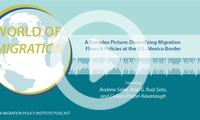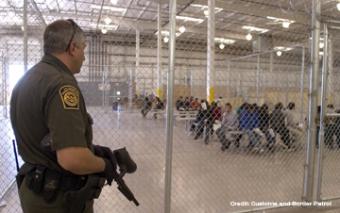Deportations/Returns
Recent Activity
The 20th annual Immigration Law and Policy Conference, organized by MPI, Catholic Legal Immigration Network, Inc., and Georgetown University Law Center, features fresh, thoughtful policy and legal analysis, and discussion of some of the top immigration issues by leading government officials, attorneys, researchers, advocates, and other experts.

This webinar explores the goals and target audiences for public-facing information campaigns on voluntary return and reintegration, how to evaluate dissemination gaps, and the risks associated with inadvertently issuing messages that are not trusted or are misunderstood.
As the U.S. immigration court system struggles with record case backlogs, decisions take years, immigration enforcement is delayed, and wait times incentivize unauthorized arrivals. This discussion examines the factors that have driven the system to the point of crisis and possible fixes.

Marking release of a report, experts on this webinar examine migration narratives since 2018 and how they have been used to justify policy approaches or incentivize mobility decisions.

How are U.S. border operations and policies evolving at the U.S.-Mexico border to address rising and diversifying flows? And what is driving increasing immigration from across Latin America, the Caribbean, and beyond? MPI President Andrew Selee speaks with two colleagues who traveled from one end of the nearly 2,000-mile boundary to the other, touring U.S. Customs and Border Protection facilities and interviewing U.S. and Mexican officials, NGO leaders, and others.
Pages
Recent Activity
The COVID-19 pandemic’s impacts on mobility in the Middle East and North Africa were immediate and wide-reaching. These include the world’s largest and most sustained repatriation efforts for stranded migrants, halted and reversed irregular journeys, and a reckoning with some countries’ reliance on foreign labor. This report examines how these impacts varied across countries in this highly diverse region, as well as the uneven recovery.
The story of the COVID-19 pandemic in Europe is chiefly one of challenges to solidarity and coordination. Cross-border movement—even within Europe’s Schengen Area—ground to a halt, and countries took varied approaches to using travel measures in an attempt to slow the virus’s spread. This report explores the pandemic’s impacts on mobility to and within Europe, its challenges to European solidarity, and lessons for future public-health crises.
















The U.S.-Mexico Border Problem Will Not Be “Solved” Until All Parts of the Border Enforcement System Are Properly Resourced
Shifting Patterns and Policies Reshape Migration to U.S.-Mexico Border in Major Ways in 2023
A Turning Point for the Unauthorized Immigrant Population in the United States
A Post-Title 42 Vision for Migration Management Comes into Focus
El número récord de encuentros con migrantes en la frontera México-Estados Unidos encubre la historia más importante
Record-Breaking Migrant Encounters at the U.S.-Mexico Border Overlook the Bigger Story
The Los Angeles Declaration Could Represent a Big Step for Real Migration Cooperation across the Americas
It Is Too Simple to Call 2021 a Record Year for Migration at the U.S.-Mexico Border
Biden Administration Asylum Processing Revamp at the U.S. Border Could Be a Game Changer
European Strategy on Voluntary Return and Reintegration Advances Action within Bloc, Leaves More to Discuss with Countries of Migrant Origin
Pages